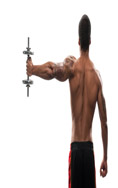How to Exercise with Lower Back Injury – Part 2
Back Exercise and Training Properly – Prehab and Mobility
Prehab and mobility work is another article I will write down the road, but I wanted to touch on it briefly. Everyone wants to get to the gym, hit it hard and go home. Keeping in mind when you train you are breaking down your muscle tissue, nervous system and more.
It is a good idea to get your body READY for the workout ahead. Prehab basically means prehabilitation, which is the opposite of rehabilitation. Rehab is what you do AFTER you are injured. Prehab is what you do to MINIMIZE getting injured. Why get injured if you can prevent it! More on this down the road.
Mobility work is around the same lines as prehab. It is good to get your body moving, and firing properly, so that it can do the job that you want it to do. Let say your goal is a sprint workout. So you don’t do any warm up, or dynamic stretching, and you just dive right into your sprints.
This is great, IF you want a hamstring tear! So prehab and mobility should always come before any workout. It will take 8-20 minutes depending on age, training experience, type of training. But it is ALWAYS worth it.
Consider this the seat belt of your car. Always buckle up!
>> Read PART 1 of How to Exercise with Lower back injury
Factors to Consider: Training with a Back Injury
A few factors that I always take into consideration with back pain/injuries and training are the following. Load, Tempo, Stability, ROM (Range of motion). Lets start with load. For load lets just keep this simple. Load for now will be simple, it is the amount of weight you use for an exercise.
For example lets say you are squatting. If you are squatting the bar (45lb) without problem, then squatting should be OK right? Well, lets say you put 315 on that bar (and your are strong enough to do it), and that weight causes you pain/discomfort.
Then the load is too high. If you can do an exercise with LIGHTER weight and still do the exercise, this is a good thing. It just means you have to LOWER YOUR WEIGHT. I know, everything you read tells you to lift more. Well when you are injured, this is the wrong thing to do!
However, if you can do an exercise without pain with lighter weight, we can introduce the next thing – Tempo. If you are familiar with tempo, then skip to the next paragraph. If not let me summarize..
Tempo is the following. The speed at which you execute an exercise. Tempo has 3 ranges – I will explain using a bench press.
Eccentric : Lowering (Once you take the bar off the rack and lower it to your chest)
Pause : When the range is at its fullest (i.e., on the bench press it is when the bar touches your chest)
Concentric : The positive side of the lift. That is, Pushing the bar off your chest on bench press.
A tempo principle would be written like this:
Tempo 6 – 1 – X 6 = 6 seconds down. 1 = 1 second pause
X = Move the weight as fast as you can, back to the start of the rep 
Simply put – if you have an injury, SLOW DOWN. Using less weight with a longer TUT (Time Under Tension) you will benefit greatly from it. Your muscles will get work, and your joints will thank you!
STABILITY TRAINING: PRECAUTIONS TO TAKE
Next up is stability training. Stability training has really gone strange over the last few years. You see bosu balls everywhere, and everywhere I see stability training, i see people doing things they shouldn’t be doing!
When defining stability, we want to look at core stability. Keeping the TVA (Transversus abdominis muscle) stable during lower body exercises is very important. If your core is unstable and you have a lower back injury or weakness, you will only make matters worse.
What I mean for this is keep your stomach tight, your core strong and stable, this will help reduce back injury and also enhance injury prevention.
Lastly is ROM = means (Range Of Motion). For the most part, you always want a full range of motion. However, if this isn’t possible (usually due to lack of mobility), I recommend modifying the exercise and making the best of it.  For example, I can’t do full squats ANY longer. (But I think they are a fantastic exercise if you can do them).
For example, I can’t do full squats ANY longer. (But I think they are a fantastic exercise if you can do them).
Yet I can do squats to a bench, without much pain. So why not use them? It is better to do something than nothing.
Recommendation: Using Single Leg Exercises
First thing I recommend, is to ditch most exercises that involve using 2 legs at once. Single leg training is the way to go!
You wont see much of this type training in Flex magazine, but if you want legs like Ronnie Coleman this isn’t the article for you. However if you want muscular, strong, functional legs, uni-lateral leg training is an excellent choice.
– The loads on the spine will be dramatically reduced.
– The leg(s) are isolated causing a much higher recruitment of muscle fiber activation. Improvement of sports – as most sports don’t have 2 legs in a set position, exerting effort (i.e., Squat or Deadlift)
– Improved Co-ordination with single leg training.
Here are My Favorite Exercises for Lower Back Recovery
Due to my own injury I have fallen in love with the following exercises:
– Single Leg Box Squats – Start using your own body weight, then progress to using a weighted vest and/ or dumbells.
Lunges. Reduced load on spine, when using dumbells. Can adjust stride length, and depth, to hit different areas of legs and hips.
– Single Leg – Stiff Leg Deadlifts. Done with a dumbell or kettlebell. Great for hamstrings, lower back and for improving your balance.
– Ski Squats – Vary heights every 30 seconds. Step Ups – Varying heights using dumbells.
– Leg Extensions – (For bodybuilding, not for sports improvement)
Sissy Squats – (Old School exercise that has great benefits for leg growth)
– Single Leg Squats against a wall with a ball. Same as ski squat, but using a ball.
Post Workout and Recovery
I am not going to go into the details of post workout nutrition here. I will just cover what I think is important from a training point of view.
The only time to do static stretching (where you place the muscle in a stretched ranged and hold), is post workout. After doing leg training, I recommend a good 10-15 minutes of cool down stretching. I always find it best to start with the hips and work your way down.
Another great post workout way to recover is alternating hot and cold shower. To do this, you run 30 seconds hot, then 30 seconds cold. It really sucks – however, it works wonders for muscle recovery.
Training with any injury is never fun. A back injury gets in the way of everything you do, but instead of looking at it negatively look at it as a challenge – make the best of your situation.
>> Read PART 1 of How to Exercise with Lower back injury <<
More: Sciatica Exercises
>> Video on Dealing with Sciatic Pain [Excellent Tips ]
How to Relieve Lower back pain during pregnancy – by MAYO CLINIC
Copyright Chiropractic Info Just for U



